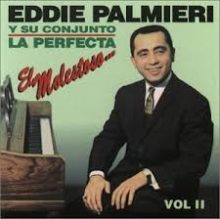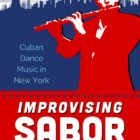A real innovator of Latin music left us on 6 August 2025 – it seems like Eddie Palmieri has been on this planet forever and his immense contribution to Cuban dance music in New York and Latin jazz will continue to hold influence. Below is an extract from my book Improvising Sabor – Cuban Dance Music in New York looking at his wonderful work with his band La Perfecta – sadly missed by all who knew him and his music Eddie Palmieri, along with his brother Charlie, leave an extraordinary body of work for us all to learn from and enjoy. Gracias por la musica Eddie E.P.D. – en paz descanse

Charanguea’o en Típico
Eddie Palmieri and La Perfecta I and II
“Juan Flores credits Eddie Palmieri as one of the most important innovators in Latin music in terms of combining both the conjunto and charanga line-up in La Perfecta, describing it as ‘two bands in one, without adding or changing personnel: for any given number he [Eddie] had either a conjunto, with trombones and bongo, or what he calls “charanguea’o,” that is, with the charanga feel, combining flute, trombones and timbales.’ Although leaving out the timbales for the more son-orientated repertoire and replacing it with bongos signifies the traditional conjunto approach, La Perfecta was not the only band combining a charanga and conjunto aesthetic. Contrary to Flores’ distinction that Pacheco abandoned the charanga for a conservative típico approach with his conjunto Nuevo Tumbao, Pacheco also continued to combine a charanguea’o approach with a conjunto line-up—but the connections are perhaps less apparent when the line-up does not include a flute (or indeed violins). Pacheco’s arrangement of ‘El Bodeguero’ on his Early Rhythms album, for example, features the brass section performing the traditional charanga violin guajeo patterns. Understanding the nuances of the two different but related approaches is, therefore, key to understanding where innovation or change is taking place. A change of instrumentation is observed more readily than more subtle indications of charanga or conjunto features, or of specific performance aesthetics associated with the two traditions. Cuban trumpeter Roberto Rodríguez improvised in a charanguea’o manner in Orquesta Broadway because he understood the charanga conventions of performance. Palmieri’s La Perfecta made instrumental line-up changes but, like Pacheco, combined elements from the charanga and conjunto in other subtle ways. His jazz inflections were more modern than Pacheco’s, however, with jazz-styled chord progressions (more ii-V-I) and greater use of chord extensions. The jazz-influenced Perfecta charts came about through trombonist Barry Rogers’ knowledge of both idioms and by Eddie Palmieri’s gradual expansion into jazz-styled harmonic language.
The original ‘La Perfecta’ band was formed in 1961 by Eddie Palmieri. The line-up varied at first, but it mostly featured a formation with Eddie Palmieri on piano, Manny Oquendo on timbales and bongo, Tommy López on congas, Bobby Rodríguez on bass, Barry Rogers, José Rodrígues and Mark Weinstein on trombones, Ismael Quintana on vocals and George (Jorge) Castro on five-key wooden flute. In the sleeve notes to La Perfecta’s debut album in 1962, Charlie Palmieri names the band as a ‘trombanga’ even though La Perfecta only had four numbers featuring the flute and trombone format (the rest of the repertoire featured either four trumpets and two trombones or four trumpets) Eddie Palmieri had initially wanted a four trumpet brass section but good trumpet players were hard to find—they were much in demand in the mambo big bands of the day. Subsequently Barry Rogers, Manny Oquendo and Eddie Palmieri worked closely together on the band’s arrangements to adapt to a slightly less conventional trombone-led conjunto with accompanying charanga flute. Barry Rogers is universally credited with defining La Perfecta’s trombone section sound which was high in register and usually very loud. Mark Weinstein has described how many of the trombone lines were improvised moñas which Barry would invent and sing to each player to imitate:
“Barry would call me over and would sing into my ear the vamp that he wanted played and I had to pick up. Sometimes I’d say ‘Do it again’ with my hand but if I didn’t pick it up in two times I didn’t have the job. I had to pick up the vamp, so I’d start the vamp and then Barry would keep on singing. Jorge would start to play. Barry would start to play the vamp in unison with me, maybe correcting my phrasing, and then he’d start to play it in harmony. Then he would start to play almost like Dixieland, a second line, and that’s when the band would take off.”
Barry Rogers was influenced by the 1950s trombone duets of jazz players J.J. Johnson and Kai Winding and knew the earlier tailgating styles too; in turn Eddie Palmieri was very influenced by Rogers. Palmieri later drew on work by McCoy Tyner and Chick Corea in his own improvisations, but in La Perfecta neither Rogers nor Palmieri deviated from the main function of the clave-based music and followed a dance imperative. In many ways the interlocking improvised lines of early jazz were aligned with the conjunto’s diablos and charanga mambos in terms of function (building up the rhythmic intensity).”
. . .
“La Perfecta of the 1960s was certainly a catalyst for innovation and in many ways the group represents a certain type of New York sabor with its fiery trombone and flute combination.”
Sue Miller
Extracts from Chapter 7 Improvising Sabor – Cuban Dance Music in New York
University Press of Mississippi
2021.
